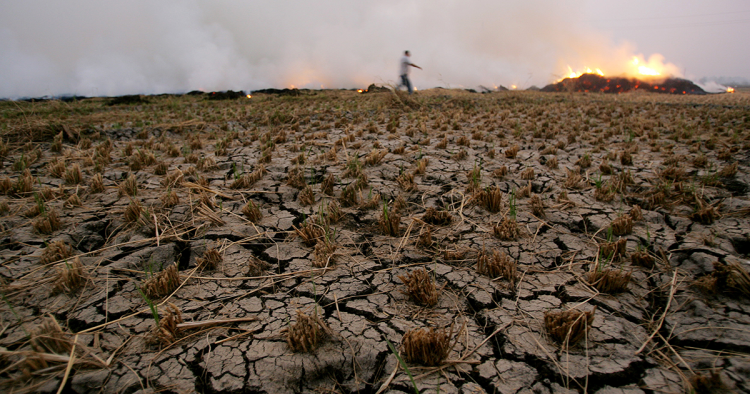This article is part of the publication Thinking MENA Futures, produced in conjunction with MEI's Strategic Foresight Initiative and the MEI Futures Forum. Read the other articles in the series here.
The most immediate threat posed by climate change to the Middle East, one that will be in the forefront of climate adaptation efforts within the next five years, is extreme heat. Average global temperatures have been projected to increase up to 1.5°C by 2030. In areas where a hotter climate is the norm, the actual increase in daily temperatures and the frequency of above-average temperature days could be higher. In extreme heat-prone regions like the Middle East, this could push daily temperature maximums well into the 50-60°C range. For coastal communities in the Middle East, these excessive temperatures alone are problematic, but when coupled with humidity and sea level rise, the cumulative effect can be devastating to infrastructure and human populations.
Public health, safety, and development
Extreme heat has direct implications for three important aspects of society that are relevant in the context of the Middle East: public health, safety, and development.
-
Public health: Minimizing occurrence of heat illness
The increased frequency of days with peak extreme temperatures (greater than 40°C) poses a direct public health risk to populations experiencing this level of heat. Prolonged exposure to these extreme temperatures carries the risk of heatstroke for those that need to work under these conditions. However, there is still risk of heat-related illness even when not directly exposed to extreme heat. Heat exhaustion can still occur when human body temperature is not properly regulated due to insufficient cooling under sustained high temperatures. This means that populations experiencing this level of heat need to have adequate cooling environments even while indoors. Even with the presence of cooling mechanisms such as air conditioning and fan units, heat exhaustion can still occur if the cooling method does not fully reduce ambient internal temperatures or is limited or prevented from being able to do so (such as by power interruptions). This need for continuous cooling during peak temperature periods places extraordinary demands on power generation in the region.
-
Safety: Maintaining integrity of infrastructure
With sustained exposure to heat (and humidity for coastal communities in the Middle East) comes an accelerated degradation of infrastructure, particularly infrastructure that is in routine use, such as roads, bridges, buildings, and other physical assets exposed to the elements (e.g. power and water treatment plants). Almost all types of infrastructure that is in place for regular utilization and operation must have a standard schedule of maintenance and repair that is appropriate for that type of infrastructure. With sustained exposure to extreme heat these physical assets will require new and updated protocols on maintenance and replacement to sustain the lifespan of these assets and reduce the likelihood of failure. In addition, external physical assets may now require enclosures with cooling mechanisms to maintain their structural integrity and limit their exposure to extreme heat.
-
Development: Supporting population and economic growth
The primary resource that supports residential and industrial development, and subsequent economic and population growth, is water. Climate change has already stressed water resources in the region by propagating hot and dry conditions. Communities in the Middle East that cannot rely on precipitation and surface water supplies for their development are in dire circumstances. Extreme heat has the potential to shift the water cycle such that both surface water supplies (driven by precipitation) and regional oceanic water bodies (that are utilized for desalination) experience higher levels of evaporation. To continue meeting the growing demands of economic and human development, alternative strategies to secure water will become more palatable and necessary. Water conservation applications (in agriculture and municipal/industrial use) and water augmentation initiatives (e.g. water reuse and cloud seeding) are additional tools that can be levied against potential water shortages.

Climate change adaptation
For the Middle East, addressing these immediate impacts of extreme heat requires a robust climate adaptation response in all sectors of administration and operations (e.g. government, utilities, and public services). But for that to happen, all the various sectors of governance will need to conduct climate vulnerability assessments prior to developing climate adaptation strategies, to evaluate how specific climate change implications affect their business. Doing so requires these sectors to comprehensively mainstream climate adaptation into their operations. This objective should be the focus and intended outcome of the Middle East in the next five years.
"For the Middle East, addressing these immediate impacts of extreme heat requires a robust climate adaptation response."
Mainstreaming climate adaptation
Mainstreaming climate adaptation into local governance is an achievable outcome in the near term for sectors in the Middle East to maintain climate resilience in a future dominated by climate change. But the process of mainstreaming climate adaptation into local governments, utilities, and public services begins with some key steps that also navigate several challenging obstacles:
- Learning from other climate adaptation efforts
Many organizations have already established their own climate adaptation programs. Initiating a mainstreaming process from scratch does not mean having to do so uninformed. Plenty of learning resources exist, especially from U.S.-based institutions, regarding establishing climate adaptation programs for different sectors in the Middle East. - Motivating climate action by making a business case for climate adaptation
Enhancing climate resiliency requires time and resources, but doing so can also save them in the long run. Validating the expenditures on climate adaptation can be better realized when linked to costs and benefits. Demonstrating tradeoffs in cost with the potential social, environmental, and financial benefits gained can create a more compelling argument for implementing and sustaining climate adaptation programs. - Identifying climate champions
Mainstreaming climate adaptation for any sector is difficult without internal leaders to champion the effort and integrate it into the business function of an organization. Climate champions do not have to be representatives of an organization’s executive leadership (though that may be extremely helpful), but they can also come from other levels within the organization. Rather, climate champions are motivated individuals who see the value of climate adaptation and can sustain and strengthen mainstreaming initiatives. - Developing a climate adaptation communication plan
A climate adaptation communication plan serves a couple of purposes and audiences. Internally, it can convey to an organization’s leadership the justification, purpose, and intended outcomes for incorporating climate adaptation into the organization’s business processes. Externally, the communication plan serves to educate the public, help foster further engagement, and create incentives for other sectors to mainstream climate adaptation as part of their business. - Prioritizing adaptation strategies
Incorporating climate adaptation into an organization’s business plan does not always need to be a difficult process with a lengthy planning timeframe. Some climate adaptation strategies can be implemented expeditiously when they have been identified as easy to implement and demonstrate a no-regrets quality to them. Such strategies usually require little to no investment and take advantage of processes already in place to maximize climate resilience, providing a benefit even if the climate implication the strategy is meant to address does not come to pass as anticipated. In fact, organizations may be surprised to find out that some of their other planning programs that are already in place are actually climate adaptation strategies. Recognizing adaptation efforts that have already been implemented may also provide added motivation for an organization to push forward new adaptation strategies.
Mohammed Mahmoud is the director of the Climate and Water Program and a senior fellow at the Middle East Institute.
Photo by KHALED DESOUKI/AFP via Getty Images
The Middle East Institute (MEI) is an independent, non-partisan, non-for-profit, educational organization. It does not engage in advocacy and its scholars’ opinions are their own. MEI welcomes financial donations, but retains sole editorial control over its work and its publications reflect only the authors’ views. For a listing of MEI donors, please click here.













